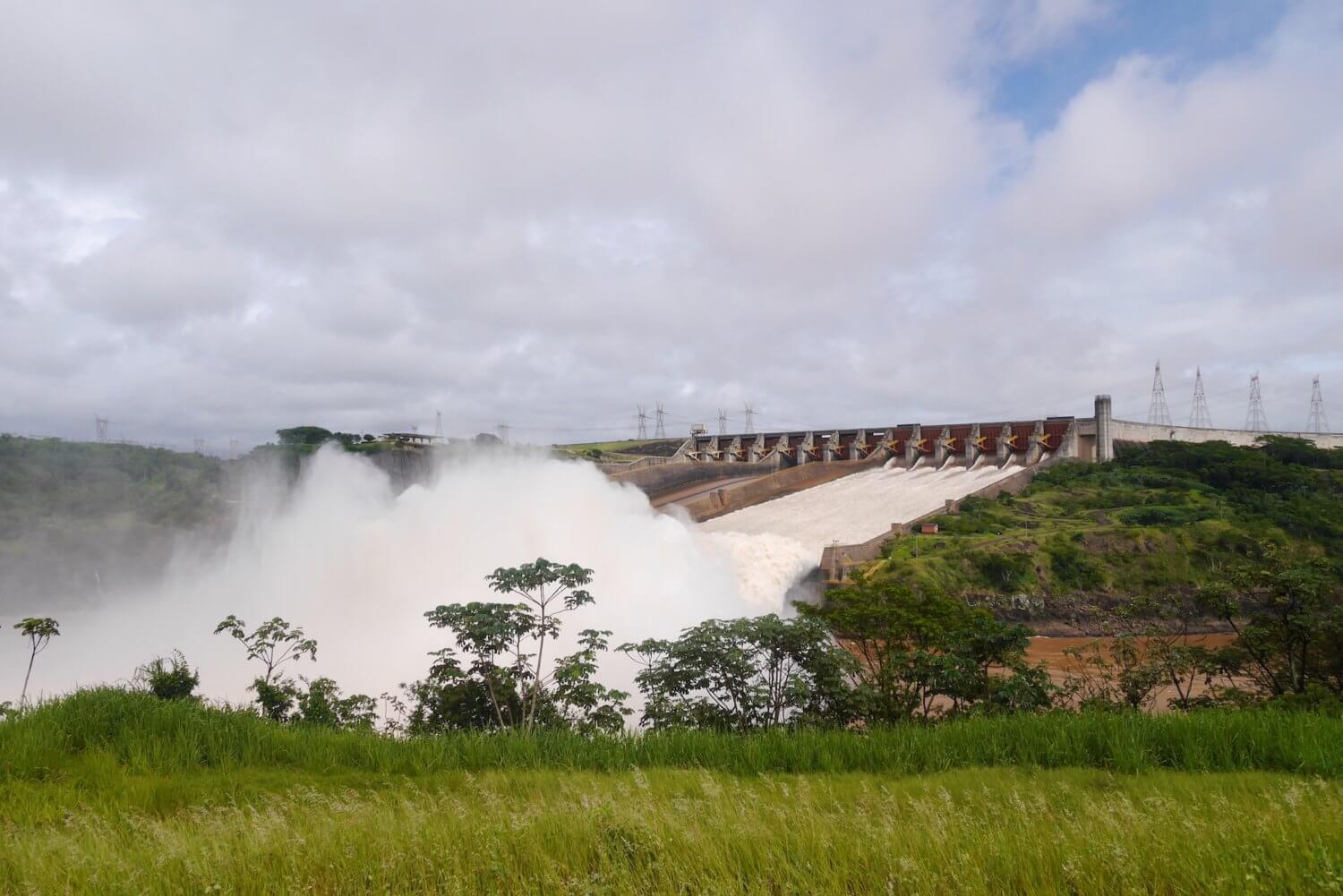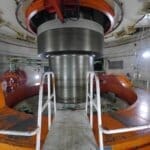Not everything on this planet that stops you in your tracks comes from nature. For good or bad, mans attempts to control nature have led to some successes and stunning failures. One of the largest hydro electric damming projects in the world is the Itaipu Dam in South America. Straddling 2 countries, Brazil and Paraguay, it creates enough electricity to power nearly 90% of Paraguay’s needs and almost 20% of Brazil.

700,000 gallons of water flows down each of the 20 pipes in 1 second to feed the massive turbines underneath and generate electricity.
The project wasn’t without controversy however at the time of construction in the late ’70s and early ’80s. The world’s largest hydroelectric dam (by volume) will need an enormous amount of water to power it. The damming of the Paraná River created a reservoir more than 200 meters deep in parts and 1350² kilometres in area but displaced countless species of animals and 10,000 families that lived next to the old river course.
The Guaìra Waterfalls was the largest by volume (twice as high as Niagra with a water flow to match) but it was swallowed up as Lake Itaipu filled. Thought by many to be the most beautiful natural water feature on the planet, it was eventually blasted by dynamite to allow safer navigation but eliminates the possibility of restoring it should the dam be decommissioned. It was an important ecological barrier to the Upper and lower Paraná Basins and since its demolition endemic species of fish have been able to invade the other areas forcing local species to adapt.
Everything about Itaipu is on a monumental scale, here are some quick facts and figures.
- It used 15 times more concrete than the Channel Tunnel between Britain and France (12.3 million³ meters).
- Has enough steel to build 380 Eiffel Towers.
- At $18 billion it’s one of the most expensive construction projects ever undertaken
- It has a total length of 7,235 meters (23,737ft) and reaches up to 225 meters high in parts (738ft).
- The enormous spillway looks tiny against this backdrop but it’s actually 483 meters long (1,585ft).
- If all the gates were opened, the rush of water from the lake would have enough force to flood Buenos Aires where the Paraná River meets the Atlantic Ocean nearly 1300km away.
- The flow from the spillways when fully open is 40 times that of neighbouring Iguaçu Falls.
- The world’s 7th biggest river was diverted to allow its construction (which took 3 years alone).
- The project took 40,000 workers to complete. Tragically 149 died during the 9 year construction.
- Due to heavy rains Lake Itaipu was created in just 2 short weeks in October 1982 with the 4 interconnected dams finally holding back a wall of water up to 200 meters high (660ft), 105 miles long (170km) and 4 1/2 miles wide (7km).
- The dam produces the same amount of electricity as a whopping 434,000 barrels of oil daily.
The dam officially opened in 1984 and almost immediately began paying its way by producing electricity, first with only 2 generators which have since grown to 20, although only 18 are active at once with the other 2 closed and drained for maintenance.

Looking down from the Cathedral walkway, the dam reaches all the way down to the original river bed.
Selected as one of the Seven Wonders Of The Modern World by the American Society Of Civil Engineers, Itaipu stands for some as a monument to our sometimes wilful disregard to the planet we all have to live on. To others it is part of the future of renewable energy as we strive as a race to reduce our dependence on fossil fuels.
For the devastation on the local area that the construction brought it now produces renewable energy that saves close to 1/2 million barrels of oil being burned daily which is a huge bonus to ecological systems worldwide. Everything about Itaipu should make you stand in awe. It should make you question what we were put on this planet for. Itaipu is truly awe inspiring for good and bad reasons. It should make you ask yourself and your friends if the financial and ecological cost was worth it.

The start of the massive Itaipu reservoir. At this point it is over 200 meters deep and 7 kilometres wide.
Itaipu Dam – Getting to Itaipu
The tourist complex is very close to the border with Argentina if you are staying in Puerto Iguaçu on the Argentinian side for the Iguaçu Falls. Getting across the border is pain free and shouldn’t take too long. Once over the border the dam is only roughly half an hour drive from Foz Do Iguaçu. The map below shows the location of the dam along with Iguaçu Falls and the closest airports.
Itaipu Dam – Getting Around Iguaçu

The appropriately named Cathedral. The shape is immensely strong to hold back the water but cut costs and drastically reduced the amount of concrete used when building the dam.
Puerto Iguaçu is relatively compact than the larger For Do Iguaçu on the Brazilian side. Either way taxi’s are a good form of transport. They’re relatively inexpensive if you spread the cost. For anything further afield tours run daily with hotel drop offs. Itaipu Dam is a popular day tour from both Puerto Iguaçu and Foz Do Iguaçu and can sometimes be run as a full day tour from the Argentinian side in conjunction with either a morning or afternoon at the Brazilian side of the falls. To really appreciate the scale of the falls I recommend seeing both sides but if you’re mind isn’t made up you can check out my view of the Argentinian Side and the Brazilian Side on the links.
Itaipu Dam – Good To Know
Staying in the area and wanting to see all the sights will entail a lot of border crossings. Using plastic to pay for purchases is easy enough but you may have a problem if you cross the border. Your card company will see a purchase made in the morning in Argentina but 2 hours later you will be in Brazil. It has led to my card being declined numbers times because of suspicious activity. Card companies don’t yet take into account geographical borders. To be safe take a small amount of either Brazilian Reals or Argentinan Pesos for which ever side you are visiting for the day.

Thousands of gallons escape the main reservoir to maintain a safe water level after historic rains. The spillways are curved to throw water up to disperse its power and save the foundations of the dam.
Itaipu Dam – Which Tour?
There are 2 main tours available: The shorter Panoramic Tour will take you around the external structure and across the top of the dam. The tour lasts about 90 minutes and has a very educational 20 minute video presentation about the construction and legacy of the dam. The special tour includes everything of the panoramic tour but includes stops at the Cathedral Station, Production Facility (which includes the main control room), the Outflow Station and Gallery Station all set inside the dam. The tour lasts 2 hours 30 minutes and can only be taken by people over 14 (sorry kids). Having done both I can highly recommend the Special Tour although it won’t be available to anyone taking the Itaipu Dam as a day trip from Argentina. You will have to book it direct though the Itaipu Binacional website and either drive or get a taxi to the dam. All photos in this post are from the Special Tour.
Itaipu Dam – What Else Is There At Itaipu?
The dam obviously is the largest tourism draw to the area but the complex covers many acres. If you want to spend a full day you won’t run out of things to do:
-
- Observatory – Expand your knowledge of the cosmos with this small yet entertaining complex aimed at budding young stargazers.
- Eco Museum – Shows the history and social and environmental culture of the dam through interactive exhibits.
- Biological Sanctuary – Set up in the 70’s to house animals displaced by the construction of the dam and ensuing flooding of vast areas of land.
- The Spawning Channel – A 10km long river that aids fish climb the 120 meters up to the reservoir. The flow of the water is good enough to hold international white water rafting and kayaking.
- Lighting Of The Dam – Visit at night for a light show like no other. A set of 519 floodlights and 112 lighting fixtures illuminate the dam against a rousing musical score. Particularly popular on nights with a full moon.

The floor runs the length of the concrete dam. Under each red cap is a turbine that weighs roughly 500,000 tonnes.
If you are curious about the effect we can have on the earth around us I encourage you to visit Itaipu. Whether you agree that it should have been built in the first place or not, there is no denying the effect it is having on the local area now. Their extensive sustainability report is published every year and is available online.
From laying thousands of meters of roadways, electrical wires and potable water stations to helping indigenous families farm better and more productively through various initiatives through to supporting children of all ages in partnership with Unicef. Itaipu supports communities by providing a regular income to thousands of workers through the operational tasks and tourism sector. It has a comprehensive environmental policy culminating it it being awarded a Water For Life award by the United Nations in 2015 meaning it has the best water management practices in the world. This award is the latest of many ecological and sustainability awards given to the company over the years.
The Itaipu of today is very different to that of when it was conceived. Born out of controversy, Itaipu has grown into one of the most environmentally responsible companies in the world and for that it should be applauded.
 Copyright secured by Digiprove © 2017
Copyright secured by Digiprove © 2017






